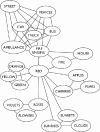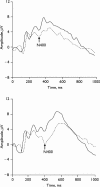Semantics and N400: insights for schizophrenia
- PMID: 15069463
- PMCID: PMC383341
Semantics and N400: insights for schizophrenia
Abstract
Thought disorder is a hallmark symptom of schizophrenia, which often leads to deficits in social functioning. Some aspects of this cognitive dysfunction are the result of abnormal characteristics in the semantic processes of patients. These abnormalities exist not only at the discourse production level, but at the discourse comprehension level as well. The recording and analysis of event-related potentials has greatly advanced the investigation of the processing of linguistic information. One particular component of event-related potentials, N400, indexes semantic processing. Whereas all meaningful words elicit an N400, the amplitude of this component is much greater in response to words that are unexpected in a given context. As such, it is thought to reflect processes involved in contextual integration, which is the key to correct comprehension. N400 has been found to be abnormal in patients with schizophrenia when compared with healthy controls and, thus, may point toward the underlying cause of semantic deficits of patients with thought disorder.
Le trouble de la pensée est un symptôme caractéristique de la schizophrénie, qui entraÎne souvent des déficits du fonctionnement social. Certains aspects de ce dysfonctionnement cognitif résultent des caractéristiques anormales des processus sémantiques des patients. Ces anomalies existent au niveau non seulement de la production, mais aussi de la compréhension du discours. La consignation et l'analyse de potentiels reliés à des événements a fait progresser considérablement l'étude du traitement de l'information linguistique. Un élément constituant particulier des potentiels reliés aux événements, l'élément N400, indexe le traitement sémantique. Alors que tous les mots significatifs provoquent un N400, l'amplitude de cet élément constituant est beaucoup plus grande face à des mots inattendus dans un contexte donné. C'est pourquoi on croit qu'il reflète des processus intervenant dans l'intégration contextuelle, ce qui constitue la clé de la compréhension correcte. On a constaté une anomalie de l'élément N400 chez des patients atteints de schizophrénie comparativement à des témoins en bonne santé, ce qui pourrait donc indiquer la cause sous-jacente des déficits sémantiques chez les patients atteints d'un trouble de la pensée.
Figures



References
-
- Bleuler E. Dementia praecox or the group of schizophrenias [Translated by J. Zinkin]. New York: International Universities Press; 1950.
-
- Haimo SF, Holzman PS. Thought disorder in schizophrenics and normal controls: social class and race differences. J Consult Clin Psychol 1979;47(5):963-7. - PubMed
-
- Andreasen NC, Grove WM. Thought, language, and communication in schizophrenia: diagnosis and prognosis. Schizophr Bull 1986;12(3):348-59. - PubMed
-
- Gambini O, Campana A, Macciardi F, Scarone S. A preliminary report of a strong genetic component for thought disorder in normals. A twin study. Neuropsychobiology 1997;36(1):13-8. - PubMed
-
- Brown CM, Hagoort P, Kutas M. Postlexical integration processes in language comprehension: evidence from brain-imaging research. In: Gazzaniga MS, editor. The new cognitive neurosciences. Cambridge: MIT Press; 2000. p. 881-95.
Publication types
MeSH terms
LinkOut - more resources
Full Text Sources
Medical
Research Materials
